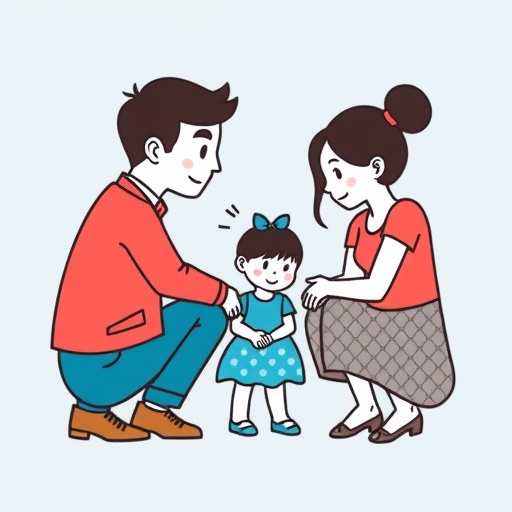In the evolving dynamics of family structures across the globe, a groundbreaking study published in “Genus” delves deeply into the nuanced effects of parental relationship quality on child wellbeing, particularly contrasting stepfamilies and traditional nuclear families. This research, conducted by Wagner, Molina, Alonso-Perez, and colleagues, offers an unprecedented technical exploration of how the intricacies of parental bonds can reverberate through the developmental trajectories of children in varying familial contexts.
Central to this investigation is the concept that not all families function with equal emotional integrity or relational stability, which can profoundly influence a child’s psychological health and social adaptation. The authors meticulously differentiate between nuclear families—defined as those where both biological parents live together with their children—and stepfamilies, wherein at least one biological parent has re-partnered, leading to blended family units. This dichotomy serves as the framework through which the study probes the multidimensional effects of parental relationship quality.
The methodology underpinning this study combined longitudinal survey data and validated psychometric instruments that measure relationship satisfaction, parental cooperation, and conflict frequency. These variables were statistically analyzed against indicators of child wellbeing, including emotional stability, academic performance, and social competence. Such a rigorous approach ensured that causal inferences maintain scientific robustness, transcending mere correlational observations.
One of the pivotal technical findings underscores that high-quality parental relationships, irrespective of family structure, serve as protective factors for children, fostering resilience and promoting healthier psychological outcomes. This nuance challenges the traditional assumption that nuclear families inherently provide a superior environment for child development merely due to genetic or structural continuity. Instead, relational quality emerges as a critical mediator.
Conversely, stepfamilies characterized by low relational quality—marked by frequent conflicts, inconsistent co-parenting strategies, and diminished emotional support—show a statistically significant increase in risk factors for various negative child outcomes. These include heightened levels of anxiety, behavioral problems, and academic decline. These findings underscore the complex psychosocial stressors that children in stepfamilies may navigate, often compounded by dynamics of loyalty conflicts and role ambiguity.
Notably, the research also elucidates the mechanisms by which parental relationship quality influences child wellbeing. The study highlights the role of emotional security theory, positing that children’s feelings of safety and stability stem directly from harmonious and cooperative parental interactions. Technically, this conceptual model integrates neurobiological evidence linking chronic familial stress to alterations in hypothalamic-pituitary-adrenal axis functioning, which mediates stress responses in children.
From a demographic perspective, the data reveal a growing prevalence of stepfamilies worldwide due to rising divorce and remarriage rates, rendering this research particularly timely and relevant to policymakers and social scientists alike. The study’s statistical models account for a breadth of sociodemographic covariates, including socioeconomic status, parental education, and cultural background, ensuring that findings are not confounded by extraneous variables.
Importantly, the authors advocate for a paradigm shift in family counseling and social services, emphasizing interventions tailored toward enhancing parental relationship quality rather than prioritizing family structure. This approach necessitates nuanced therapeutic techniques focusing on conflict resolution, co-parenting cohesion, and emotional expressiveness, tailored to the unique challenges facing stepfamilies.
The implications for education systems are profound. Children experiencing poor parental relationship quality, especially in complex family structures, may require targeted psychosocial support within schools to mitigate the adverse effects on learning and social integration. Incorporating family-based assessments into educational monitoring could help identify at-risk children more effectively.
Technically, this study’s sophisticated use of hierarchical linear modeling enables the disentanglement of individual and family-level effects, providing a clearer picture of the interplay between parental dynamics and child outcomes. This statistical rigor lends credence to the assertion that family relational quality is a critical determinant of child wellbeing, transcending structural categorizations.
Moreover, the research calls attention to the heterogeneity within stepfamilies themselves. Variations in how step-parents engage with children, the duration since family restructuring, and the presence of half-siblings or multiple adults in the household all modulate the impact on child wellbeing. These subtleties reflect the complex reality of modern family systems and challenge simplistic binary comparisons.
Future research directions outlined by Wagner and colleagues point to the necessity of longitudinal interventions assessing changes in parental relationship quality over time and their dynamic effects on children. Such investigations would benefit from integrating biological markers of stress and resilience to advance the biopsychosocial model of child development within diverse family contexts.
In sum, this landmark study elucidates that parental relationship quality—marked by emotional support, cooperative parenting, and minimal conflict—is a pivotal determinant of child wellbeing, starkly influencing outcomes in both step- and nuclear family arrangements. This insight calls for a reevaluation of how societies understand, support, and nurture family units amid shifting social landscapes.
By framing the family not merely by its composition but by the quality of relational processes within it, the research offers a scientifically rigorous yet humanistic lens that policymakers, practitioners, and academics can harness to foster healthier generations. Its high impact resonates across disciplines, from psychology and sociology to public health and education.
This comprehensive analysis signals a critical juncture in family studies, urging a paradigm shift from structural emphasis toward relational excellence. As stepfamilies become increasingly common, these insights provide a clarion call to ensure all children grow up in environments where parental relationships nurture their full potential.
Subject of Research: The study focuses on the impact of parental relationship quality on child wellbeing, contrasting stepfamilies and nuclear families.
Article Title: What difference does it make? Parental relationship quality and child wellbeing in step- and nuclear families.
Article References:
Wagner, L., Molina, S., Alonso-Perez, E. et al. What difference does it make? Parental relationship quality and child wellbeing in step- and nuclear families. Genus 81, 34 (2025). https://doi.org/10.1186/s41118-025-00269-w
Image Credits: AI Generated




